DualShock
The DualShock (originally Dual Shock; trademarked as DUALSHOCK or DUAL SHOCK; later named DualSense) is a line of gamepads with vibration-feedback and analog controls developed by Sony Interactive Entertainment for the PlayStation family of systems.[1] The DualShock was introduced in Japan in November 1997 and launched in the North American market in May 1998. First introduced as a secondary peripheral for the original PlayStation, an updated version of the PlayStation console included the controller. Sony subsequently phased out the digital controller that was originally included with the console, as well as the Sony Dual Analog Controller. As of 2008, more than 28 million DualShock controllers have been sold, excluding bundled controllers.[2]
DualShock
 Original grey version of the DualShock controller | |
| Developer | Sony Computer Entertainment |
|---|---|
| Manufacturer | Sony Corporation |
| Type | Video game controller |
| Generation | Fifth generation |
| Lifespan | November 20, 1997[3] |
| Input | Controller Port
|
| Connectivity | PlayStation (2) controller port |
| Dimensions | Body
Cable
|
| Predecessor | Dual Analog |
| Successor | DualShock 2 |


The DualShock Analog Controller (SCPH-1200), a controller capable of providing vibration feedback, was based on the onscreen actions taking place in the game (if the game supports it), as well as analog input through two analog sticks. Its name derives from its use of two (dual) vibration motors (shock). These motors are housed within the handles of the controller, with the left one being larger and more powerful than the one on the right, so as to allow for varying levels of vibration. The DualShock differs from the Nintendo 64's Rumble Pak in this respect as the Rumble Pak only uses a single motor. The Rumble Pak uses battery power for the vibration function but all corded varieties of the DualShock use power supplied by the PlayStation. The rumble feature of the DualShock is similar to that of the first edition of the Japanese Dual Analog Controller, a feature that was removed shortly after that controller was released.
The DualShock, like its predecessor the Dual Analog controller, has two analog sticks. Unlike the earlier controller, the DualShock's analog sticks feature textured rubber grips rather than the smooth plastic tips with recessed grooves found on the Dual Analog controller. Other differences between Dual Analog and the DualShock include the longer grips/handles and slightly different L2/R2 buttons. The Dual Analog controller also has an additional mode accessible by pressing the "Analog" button that provides compatibility with the PlayStation Analog Joystick which results in the analog indicator light turning green instead of red; this feature was removed in the DualShock.
The DualShock controller is widely supported; shortly after its launch most new games, including Crash Bandicoot: Warped, Spyro the Dragon, and Tekken 3 include support for the vibration feature and dual analog sticks, and Capcom re-released Resident Evil: Director's Cut and Resident Evil 2 with support for the controller added to these newer versions. Some games designed for the Dual Analog's vibration capability, such as Porsche Challenge and Crash Bandicoot 2, also work. Many games take advantage of the presence of two motors to provide vibration effects in stereo including Gran Turismo and the PlayStation port of Quake II. Released in 1999, the PlayStation hit Ape Escape is the first game to explicitly require DualShock/Dual-Analog-type controllers, with its gameplay requiring the use of both analog sticks. In 2000, when the PS one (a remodeled version of the original PlayStation) was released with the slightly redesigned DualShock Controller (SCPH-110), similar to the first one, except its color is white instead of gray, in the middle of the controller has the "PS one" logo, instead of the "PlayStation" naming, most of the buttons, analog sticks and the cord are brighter than the previous one, and the connector is more of a semi-circle shape than having round edge, it also came in colors.
The DualShock is compatible with the PlayStation 2, as they use the same connector and protocol. However, certain PS2 games that utilize the DualShock 2's analog buttons, such as The Bouncer, are not compatible with the DualShock. The DualShock is fully compatible with the PlayStation 2's ability to play PlayStation games.
DualShock 2
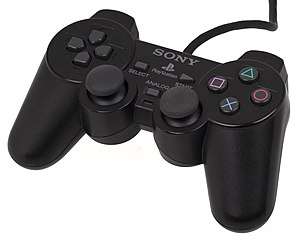 DualShock 2 controller | |
| Developer | Sony Computer Entertainment |
|---|---|
| Manufacturer | Sony Corporation |
| Type | Video game controller |
| Generation | Sixth generation |
| Lifespan | |
| Input |
|
| Connectivity | PlayStation (2) controller port |
| Dimensions | Body
Cable
|
| Mass | 7.4 oz (0.21 kg) |
| Predecessor | DualShock |
| Successor | Sixaxis, DualShock 3 |
The DualShock 2 Analog Controller (SCPH-10010) included with PlayStation 2's launch is almost identical externally as the previous DualShock analog controller, with a few minor cosmetic changes. It has different screw positioning and one fewer screw. A blue DualShock 2 logo was added to the top of the controller, the connector is more square than the DualShock, and both the cable and connector are black rather than grey. The standard controller is black (other colors came later), rather than grey as with the original DualShock. The analog sticks are also noticeably stiffer than on the original DualShock.
Internally, the DualShock 2 was lighter and all of the buttons (except for the Analog mode, start, select, L3 and R3 buttons) were readable as analog values (pressure-sensitive).[4]
The DualShock 2 has been made available in various colors: black, satin silver, ceramic white, slate grey, ocean blue, emerald green, crimson red, and candy pink.
The original PlayStation is forward compatible with the DualShock 2. The PlayStation 3 is backward compatible with the DualShock and DualShock 2 by the use of third party peripherals, which connect the controller to the console via a USB port. However, the DualShock and DualShock 2 will not work properly with games that require Sixaxis functionality, such as Heavy Rain.
DualShock 3
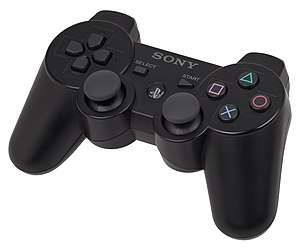 DualShock 3 controller | |
| Developer | Sony Computer Entertainment |
|---|---|
| Manufacturer | Sony Corporation |
| Type | Video game controller |
| Generation | Seventh generation |
| Lifespan | |
| Input |
|
| Connectivity | USB, Bluetooth (PS3 and PSP Go) |
| Power | Lithium-ion battery (3.7 V 300 mA or 5.0 V 500 mA), USB host powered |
| Dimensions | 160 mm × 97 mm × 55 mm 6.20 in × 3.78 in × 2.20 in |
| Mass | 192 g 6.77 oz |
| Predecessor | Sixaxis, DualShock 2 |
| Successor | DualShock 4 |
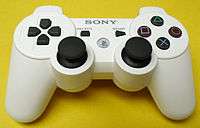
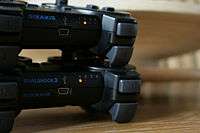
Announced at the 2007 Tokyo Game Show, the DualShock 3 wireless controller (SCPH-98050/CECHZC2) is a gamepad for the PlayStation 3. It replaces the Sixaxis wireless controller originally released with earlier versions of the console. The DualShock 3 is nearly identical to the previous Sixaxis version but adds the haptic feedback – also known as force feedback – capabilities found in the DualShock and DualShock 2. Sony settled a patent infringement lawsuit with Immersion in March 2007 following a lengthy legal battle. The settlement cleared the way for incorporating the missing "rumble" feature that the Sixaxis lacked.[7] Both the vibration function and motion-sensing capabilities of the DualShock 3 can be used simultaneously without one interfering with the other. Like the Sixaxis, it also has a USB mini-B port for charging and can also be used on a PSP Go via Bluetooth, though the controller and the PSP Go must be registered using a PS3 console.
The DualShock 3 can be identified by its "DualShock 3" and "Sixaxis" markings. It also weighs 192 grams (6.8 oz), 40% more than its predecessor, the Sixaxis, which weighed only 137.1 grams (4.84 oz).
The rear markings indicate the original DualShock 3 draws up to 300 mA of current at 3.7 V for a power consumption of 1.11 W, an order of magnitude increase from the 30 mA of current at 3.7 V (0.111 W) listed on the Sixaxis. However, this current is not drawn constantly and is the maximum current when the rumble is active. Its main power source is an internal 3.7 V Li-ion battery tentatively capable of storing 570 mAh, which provides up to 30 hours of continuous gaming on a full charge. Third party replacement batteries are also available. Like the Sixaxis, the DualShock 3 comes with instructions on how to remove and replace the battery. The DualShock 3 can also draw power over a USB cable via a USB mini-B connector on the top of the controller. This allows the controller to be used when the battery is low and is also used for charging the battery. When connected via USB, the controller communicates with the console through the USB cable, rather than Bluetooth.
Along with the release of the 'slim' model PS3, Sony released a new version of the DualShock 3 (A1) which uses 5.0 V at 500 mA while connected, but still contains a 3.7 V battery. This revision of the DualShock 3 does away with the additional plastic brackets between the L1/R1 buttons and the L2/R2 triggers (increasing controller rigidity), has indicator lights soldered directly to the board, and comes in slightly revised color schemes.
While the DualShock 3 is compatible with any standard USB mini-B cable and many USB chargers, official charging cables are available from Sony. These include an official cable, the USB 2.0 Cable Pack and a wall charger, the AC adapter charging kit. Any third-party USB charger used must act as a USB host device, rather than simply providing power over the appropriate pins, since both the Sixaxis and DualShock 3 require a host signal to "wake up" and begin charging.
A Sony representative confirmed on April 2, 2008 that the original Sixaxis controller would officially be discontinued with the release of the force-feedback enabled DualShock 3 in mid-April 2008. The Sixaxis was no longer produced after 2008, being dropped from stock by most retailers.[8]
Variations
The DualShock 3 has been produced in various colors: black, satin silver, ceramic white, classic white,[9] metallic blue, deep red,[10] pink,[11] "jungle green" (olive),[12] "candy blue" (light blue),[13] "urban camouflage" (three-color digital camouflage),[14] "crimson red" (transparent red), and "cosmic blue" (transparent blue).[15] Not all colors have been made available in all markets or at all times.
Additional colors have also been made available alongside limited edition consoles, including gun-metal grey[16] and "cloud black" (dark grey).[17]
A limited edition baseball themed DualShock 3 controller was released on March 8, 2011 to coincide with the release of MLB 11: The Show.[18] Another color, "Metallic Gold", became available in June 2012 as a limited edition in Europe,[19] while in North America it is sold exclusively in GameStop from October 2012.[20][21] A limited edition God of War: Ascension controller is available in the UK as part of a console bundle to coincide with the launch of the game[22] and in the Americas as a game and controller bundle. On November 1, 2013 Sony announced a new see-through "Crystal" model of the DualShock 3 controller in Japan.[23]
DualShock 4
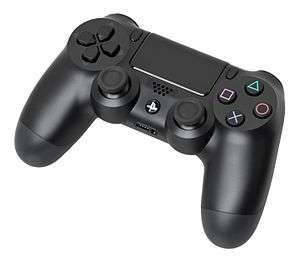 DualShock 4 controller | |
| Developer | Sony Interactive Entertainment |
|---|---|
| Manufacturer | Sony Corporation |
| Type | Video game controller |
| Generation | Eighth generation |
| Lifespan |
|
| Input |
|
| Connectivity | microUSB (Micro-B) 2.0, Bluetooth v2.1+EDR,[25] 3.5mm TRRS (OMTP) stereo headset jack, extension port |
| Power | 3.7 V 1000 mAh Li-ion battery,[25] USB 3.0 host powered |
| Dimensions | 162 mm × 52 mm × 98 mm[25] 6.4 in × 2.0 in × 3.9 in |
| Mass | 210 g[25] 7.4 oz |
| Predecessor | DualShock 3 |
| Successor | DualSense |
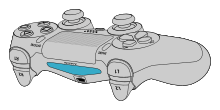
The DualShock 4 (CUH-ZCT1) is the PlayStation 4's controller. It is similar to the DualShock 3, with several new features. One new feature is a built-in two-point capacitive touch pad on the front of the controller, which can be clicked.[25] This allows the touch pad to represent multiple buttons, as demonstrated in the PS4 version of Elite Dangerous in which the four corners of the touch pad can be mapped to a separate clickable actions.[26] The controller supports motion detection via a three-axis gyroscope and three-axis accelerometer and vibration.[25] It includes a non-removable,[27] rechargeable 3.7 V, 1000 mAh lithium-ion battery, which can be charged while the system is in rest mode. It weighs 210 g (7.4 oz) and has dimensions of 162 mm × 52 mm × 98 mm (6.4 in × 2.0 in × 3.9 in).[27] It also lacks a Sony logo on the front due to the touch pad in its place.
The top of the gamepad features a light bar with three LEDs that illuminate in different colors, which can be used to identify players by matching the colors of the characters they are controlling in a game, or to provide enhanced feedback or immersion by changing patterns or colors in reaction to gameplay. (Example: In Grand Theft Auto V when the player is wanted by the police the light bar flashes red & blue).[28][29] It is also used in conjunction with the PlayStation Camera to judge the positions and movements of multiple players.[28] The light bar was developed for PlayStation VR.[30]
The controller features several input and output connectors: a stereo headset jack (3.5 mm OMTP TRRS connector), a micro-USB port and an extension port.[25] It can be charged using a dedicated charging station, via microUSB using a standalone charger, or the console (even when the console is off).[25] It also includes a mono speaker, like the Wii Remote, and is the second major controller in video game history to have such feature.[25]
The DualShock 4 features the following buttons: PS button, SHARE button, OPTIONS button, directional buttons, action buttons (triangle, circle, cross,[31] square), shoulder buttons (R1/L1), triggers (R2/L2), analog stick click buttons (L3/R3), and a touch pad click button.[25] These mark several changes from the DualShock 3 and other previous PlayStation controllers. The START and SELECT buttons have been merged into a single OPTIONS button.[25][27] A dedicated SHARE button allows players to upload screenshots and videos from their gameplay experiences.[25] The joysticks and triggers have been redesigned based on developer input,[25] with the ridged surface of the joysticks now featuring an outer ring surrounding the convex dome caps.
The DualShock 4's buttons differ slightly in functionality from the DualShock 3. Only the L1, L2, R1 and R2 buttons are pressure-sensitive, a change from the functionality of the DualShock 2 and 3. This is likely due to the fact that most games did not utilize these buttons as well as due to it not being used on competitors' controllers.
The PlayStation 3 is forward compatible with the DualShock 4 (originally only via a microUSB cable). Firmware update 4.60 for the PS3 added wireless connectivity; however, motion and vibration functions are not supported.[32] As the START and SELECT buttons are no longer present, the OPTIONS and SHARE buttons respectively replace them.
Version issues and modifications
Sony's initially-released DualShock 4's (estimated at around 10%) had wear issues with the rubber surface on the left analog stick, which exhibited excessive wear or tearing after short-term use. In January 2014, Sony issued a statement acknowledging an issue on a small percentage of controllers.[33]
In early September 2016, Sony confirmed a second generation of DualShock 4 controllers, known as the DualShock V2 (CUH-ZCT2), which hosts slight improvements over the original DualShock 4, including USB communication, a longer battery life and the ability to see the light bar from the top of the touchpad. It released on September 15, 2016.[34]
In the initial controller version, the light bar is a permanently illuminated, bright-colored light. The needless light pollution and battery drain prompted inquiries as to whether the light bar could be switched off by users. Sony executive Shuhei Yoshida initially responded in the negative in July 2013,[35][36] though game developers have the option to disable the light in game.[37] In early 2014, the company announced that a future update would allow the light bar to be dimmed,[38] which was delivered in 1.70 in April 2014.[39])
Variations
The original DualShock 4 (CUH-ZCT1) is available in Jet Black, Glacier White, Urban Camouflage, Wave Blue (black back), Magma Red (black back), Gold, Silver, and Steel Black.[40]
The newer DualShock 4 (CUH-ZCT2) has been produced in Jet Black, Glacier White, Green Camouflage, Blue Camouflage, Red Camouflage, Rose Gold, Electric Purple, Wave Blue (blue back), Magma Red (red back), Gold, Silver, Sunset Orange, Crystal, Red Crystal, Blue Crystal, Steel Black, Midnight Blue,[41] Metallic Copper, Alpine Green, and Berry Blue.
Exclusive console bundles with DualShock 4 include the 20th Anniversary Edition, Gun Metal, Batman: Arkham Knight, Metal Gear Solid V, Call of Duty: Black Ops III,[42] Uncharted 4: A Thief's End, Star Wars Battlefront, Monster Hunter World, God of War, Gran Turismo Sport, Call of Duty: World War II, the Days of Play, Marvel's Spider-Man, Death Stranding,[43] The Last of Us Part II,[44] and the 500 Million Limited Edition PS4 Pro.
DualSense
| Developer | Sony Interactive Entertainment |
|---|---|
| Manufacturer | Sony Corporation |
| Type | Video game controller |
| Generation | Ninth generation |
| Input |
|
| Predecessor | DualShock 4 |
The DualSense is the PlayStation 5's controller and was unveiled on April 7, 2020. It is based on the DualShock 4 controller that came before it but with an evolution to its design and capabilities influenced by discussions with game designers and players.
Unlike previous DualShock controllers, the DualSense has a two-tone coloring scheme (primarily white with black facing) and monochrome action buttons. It incorporates a more ergonomic design that is somewhat bigger and rounder than the DualShock 4. [46] The light bar has been moved from the top of the controller to the left and right edges of the touchpad. While the controller maintains the same number of buttons as the DualShock 4, the "Share" button has been replaced with "Create" with an expanded focus on creating content to share with others.[47] The DualSense has strong haptic feedback through voice coil actuators, which are intended to give better in-game feedback. The controller speaker has been improved and is now augmented by a new built-in microphone array allowing players to speak to others using only the controller.[47][48][49] The controller has adaptive triggers that can change the resistance to the player as necessary, supporting an experience such as virtually drawing an arrow from a bow.[47] Connectivity includes a 3.5mm audio jack and USB-C, which replaces the microUSB port on the DualShock 4.[50] Its battery has been upgraded to a higher-rated capacity.[47]
Reception
The DualShock controller was given an Emmy Award for "Peripheral Development and Technological Impact of Video Game Controllers" by The National Academy of Television Arts & Sciences on January 8, 2007.[51][52][53]
See also
- PlayStation Controller
- Dual Analog Controller
- Sixaxis
References
- Morell, Chris (March 20, 2008). "Feature: Ready to Rumble: PS3 DualShock 3 vs. Sixaxis". GamePro. Archived from the original on August 12, 2008. Retrieved March 21, 2015.
- "DualShock 3 Wireless Controller available for PlayStation 3 this summer". Next-Gen.biz. 2008-07-01. Retrieved 2008-07-01.
- "SCPH". maru-chang.org.
- Zdyrko, Dave (September 27, 2001). "Dual Shock 2 Review". IGN. Retrieved March 21, 2015.
- Yam, Marcus (April 3, 2008). "SIXAXIS PS3 Controller Discontinued; DualShock 3 is Here". DailyTech. Archived from the original on March 4, 2016. Retrieved March 21, 2015.
- "DUALSHOCK3 Wireless Controller available for PLAYSTATION3 this summer". Sony Computer Entertainment Europe. 2008-06-30. Archived from the original on 2008-07-11. Retrieved 2008-06-30.
- Cohen, Peter (February 26, 2008). "PS3 DualShock 3 controller coming in April". Macworld. Retrieved March 21, 2015.
- Cavalli, Earnest (April 2, 2008). "Sixaxis Discontinued in Favor of DualShock 3". Wired. Retrieved March 21, 2015.
- Hollister, Sean (September 5, 2010). "'Classic White' DualShock 3 appears at e-tail, dreaming of an alabaster console". Engadget. Retrieved March 21, 2015.
- Miller, Paul (July 28, 2009). "Sony's red and blue DualShock 3 controllers land in October, love this country". Engadget. Retrieved March 21, 2015.
- McElroy, Griffin (September 10, 2010). "Pink DualShock 3 controller coming September 21". Engadget. Retrieved March 21, 2015.
- "Amazon.com: DualShock 3 Controller - Jungle Green: Video Games". Retrieved 2010-12-26.
- "Japan: New PS3 controller colour, peripherals announced". CVG. March 1, 2011. Retrieved March 1, 2011.
- "DUALSHOCK®3 – Urban Camouflage - PlayStation®3 Accessories". Sony. Retrieved 2011-09-13.
- "'Sonic Blue' DualShock 3 at Wal-Mart".
- "Gunmetal Grey PS3 Coming to North America". Shacknews. 2008-04-10. Retrieved September 10, 2010.
- North, Dale (January 19, 2009). "Final Fantasy VII Advent Children PS3 bundle is real". Destructoid. Retrieved March 21, 2015.
- "Amazon.com: PS3 DualShock 3 Wireless Controller - MLB 11 The Show Edition: Video Games". Retrieved December 26, 2010.
- "On Your Marks, Get Set, Go…! – PlayStation.Blog.Europe". PlayStation.Blog.Europe. June 5, 2009. Retrieved July 20, 2012.
- "DUALSHOCK 3 wireless controller - Metallic Gold - GameStop Exclusive".
- Fletcher, JC (June 15, 2012). "PS3 controller goes 'metallic gold' at GameStop". Engadget. Retrieved March 21, 2015.
- "God of War: Ascension white PS3 bundle unveiled for UK". Joystiq. AOL. 2012-02-06. Archived from the original on 2013-04-02. Retrieved 2013-02-08.
- Corriea, Alexa (November 1, 2013). "Crystal see-through DualShock 3 hitting Japan next month". Polygon. Retrieved March 21, 2015.
- Sony Computer Entertainment. "Press Release from Sony". Archived from the original on 13 April 2013. Retrieved 21 February 2013.
- (c)Sony Computer Entertainment Inc. "NEW SLIMMER AND LIGHTER PLAYSTATION®3 TO HIT WORLDWIDE MARKET THIS SEPTEMBER | PRESS RELEASES | Sony Computer Entertainment Inc". Scei.co.jp. Archived from the original on 2013-04-13. Retrieved 2013-02-21.
- Frontier Developments plc. ""WHAT IS THE DEFAULT PS4™ CONTROLLER SETUP FOR ELITE DANGEROUS?"". Retrieved July 22, 2020.
- McWhertor, Michael (2013-01-31). "PS4 touch-sensitive DualShock 4 controller revealed (update: features, scale detailed)". Polygon. Retrieved 2013-02-21.
- (c)Sony Computer Entertainment Inc. (February 20, 2013). "Sony Computer Entertainment Introduces Wireless Controller For Playstation®4 (DUALSHOCK®4) And Playstation®4 Eye | Sony Computer Entertainment Inc". Sony.com. Archived from the original on October 23, 2013. Retrieved October 22, 2013.
- (c)Sony Computer Entertainment Inc. (October 3, 2013). "Transistor and the Secrets of DualShock 4 | PlayStation.Blog". blog.us.playstation.com. Retrieved October 22, 2013.
- Matulef, Jeffrey (8 May 2014). "The DualShock 4's light bar was developed for Project Morpheus". Eurogamer. Gamer Network. Retrieved 8 May 2014.
- Gilbert, Ben. "You've been calling the X button on the PlayStation controller the wrong name for decades". Business Insider.
- Pitcher, Jenna (July 2, 2014). "DualShock 4 controller now works wirelessly with the PlayStation 3". Polygon. Retrieved March 21, 2015.
- L., Stefan. "Sony Responds to DualShock 4 Wearing & Tearing". TheSixthAxis. Retrieved March 21, 2015.
- New Official PS4 Peripherals Announced, Includes New DualShock 4, PS Camera and Headset
- Martin, Liam (July 8, 2013). "PS4: DualShock 4 light bar doesn't switch off". Digital Spy. Hearst. Retrieved March 21, 2015.
- Plafke, James (January 20, 2014). "PS4 DualShock 4 light bar will plague you forever, says Sony". Geek. Retrieved March 21, 2015.
- Shaul, Brandy (July 10, 2013). "PS4: Developers can choose to turn off DualShock 4 light bar". Digital Spy. Hearst. Retrieved March 21, 2015.
- "GDC: PS4 Update Will Allow DualShock Light Bar to Be Dimmed", uk.ign.com, 20 Mar 2014
- Grant, Adam (Apr 2014). "PS4 system update 1.70 launches today – full feature list". blog.eu.playstation.com.
- Gamescom: Magma Red, Wave Blue DualShock 4 Colors Announced - IGN. Au.ign.com. Retrieved on 2013-08-23.
- Mason, Andrew (2018-01-31). "Introducing the new Steel Black and Midnight Blue Dualshock 4 controllers, out 7th March". PlayStation.Blog.Europe. Retrieved 2018-06-10.
- "Call of Duty: Black Ops III Limited Edition PlayStation 4 Bundle Out 11/6". PlayStation.Blog. Retrieved 2015-11-12.
- "Death Stranding Limited Edition Playstation 4 Pro Bundle".
- "Limited Edition The Last of Us Part II PS4 Pro Bundle".
- Sony Computer Entertainment. "Press Release from Sony". Archived from the original on 13 April 2013. Retrieved 21 February 2013.
- "Does PS5's DualSense Controller Earn The Criticism For Looking Like Xbox's?". ScreenRant. 8 April 2020.
- Nishino, Hideaki (April 7, 2020). "Introducing DualSense, the New Wireless Game Controller for PlayStation 5". PlayStation Blog. Retrieved April 7, 2020.
- Gartenberg, Chaim (April 8, 2020). "Sony's new DualSense controller is its most exciting design since the original PlayStation". The Verge.
- Liao, Shannon (April 7, 2020). "Sony unveils its new PlayStation 5 controller, the DualSense". CNN.
- Gravelle, Cody (April 8, 2020). "Don't Worry, The PlayStation 5 Controller Has An Audio Jack". Screen Rant. Retrieved April 8, 2020.
- "National Television Academy Announces Emmy Winning Achievements: Honors Bestowed at 58th Annual Technology & Engineering Emmy Awards". 2007-09-20. Archived from the original on 2007-12-16. Retrieved 2008-01-11.
- "Sony Computer Entertainment America Wins Emmy Award for PLAYSTATION3 SIXAXIS Wireless Controller". Sony Computer Entertainment America. 2007-01-08. Archived from the original on 2007-01-10. Retrieved 2008-01-11.
- Thorsen, Tor (January 10, 2007). "CES 07: Sony retracts Sixaxis Emmy claims". GameSpot. CBS. Retrieved March 21, 2015.
External links
| Wikimedia Commons has media related to |
- Official North American DualShock 3 page
- Official European DualShock 3 page
- Official European PlayStation 4 site, which includes details of the DualShock 4
- Official North American PlayStation 4 site, which includes details of the DualShock 4
